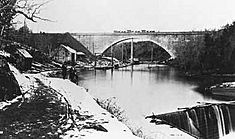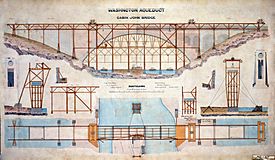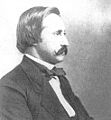Union Arch Bridge facts for kids
Quick facts for kids |
|
|
Union Arch Bridge
|
|

Union Arch Bridge in 2008. The Cabin John Parkway is seen running underneath the bridge.
|
|
| Location | Cabin John, Maryland |
|---|---|
| Built | 1857–1864 |
| Architect | Meigs, Montgomery C. |
| NRHP reference No. | 73000932 |
| Added to NRHP | February 28, 1973 |
The Union Arch Bridge, also known as the "Cabin John Bridge," is a very old and important stone bridge in Cabin John, Maryland. It was built to carry water as part of the Washington Aqueduct, which brings drinking water to Washington, D.C. Construction started in 1857 and finished in 1864. The bridge was designed by Alfred Landon Rives and built by the United States Army Corps of Engineers under the leadership of Lieutenant Montgomery C. Meigs.
This amazing bridge was named a Historic National Civil Engineering Landmark in 1972. It was also added to the National Register of Historic Places in 1973, recognizing its special historical value.
Contents
What Makes the Bridge Special?
The Union Arch Bridge is 450 ft (140 m) long and 20 ft (6.1 m) wide. It is made from strong Massachusetts granite and red sandstone from a nearby quarry. The bridge stands tall, about 101 ft (31 m) above Cabin John Creek.
How Big is the Main Arch?
The main arch of the bridge is 220 ft (67 m) long and rises 57 feet 3 inches (17.45 m) high. When it was finished in 1864, this main arch was the longest single stone arch in the world! It held this record for a long time, until 1903. That's when the 218-foot (66 m) Pont Adolphe Bridge opened in Luxembourg.
The Union Arch Bridge looks a lot like the Grosvenor Bridge in Chester, England. That bridge crosses the River Dee and was opened in 1832 by Princess Victoria, who later became Queen.
Messages Carved on the Bridge
During its construction, the bridge had a few different names, like "Union Arch," "Bridge No. 4," or "Cabin John Bridge." But only "Union Arch" was carved into the stone.
In 1861, as the bridge was almost done, plans were made for stone tablets to be placed on it. Captain Meigs wanted a tablet on the east side to say "Union Bridge" and include his name and Alfred L. Rives' name. However, Rives joined the Confederate States Army during the Civil War. So, the final tablet was changed to "Union Arch," and Rives' name was replaced with "Esto Perpetua" (which means "Let it last forever").
Even today, some people call it the "Union Arch," while others call it the "Cabin John Bridge."
The Jefferson Davis Name Story

The bridge project began in 1853, when Franklin Pierce was President and Jefferson Davis was the Secretary of War. Captain Meigs also planned a tablet for the west side of the bridge. This tablet was supposed to list the leaders in office when the project started (Pierce and Davis) and when it finished (President Abraham Lincoln and Secretary of War Simon Cameron).
But by 1862, Jefferson Davis had become the President of the Confederate States of America. Some members of Congress were upset about his name being on the bridge. So, they ordered his name to be removed from the tablet.
Years later, in 1908, President Theodore Roosevelt was asked to put Davis's name back. President Roosevelt agreed, and the name was restored.
Why the Bridge Name Can Be Confusing
More confusion about the bridge's name happened in the early 1960s. That's when the Capital Beltway was built. The new Beltway bridge over the Potomac River was also sometimes called the "Cabin John Bridge."
However, in 1969, the Beltway bridge was officially named the "American Legion Memorial Bridge." This helped clear up some of the confusion between the two bridges.
Why is the Bridge Important Today?
The Union Arch Bridge is still very important. It continues to carry water for the Washington Aqueduct. It also supports a road called MacArthur Boulevard.
To keep traffic safe, the road over the bridge is narrowed to one lane. Traffic lights control which direction of cars can cross at a time. There's also a concrete barrier that creates a separate walkway for people to cross safely. Metal fences on both sides help keep pedestrians safe. Signs on the bridge remind road crews not to use salt in winter, which can damage the old stone.
The U.S. Army Corps of Engineers completed a major update of the bridge in 2001 to keep it in good condition.
Images for kids







